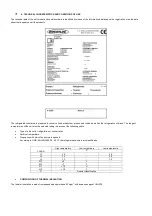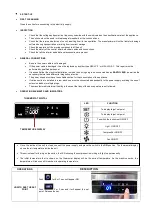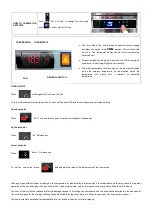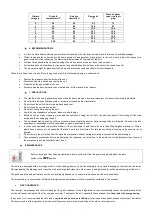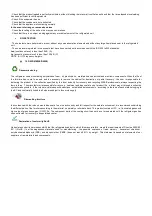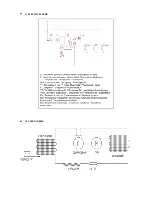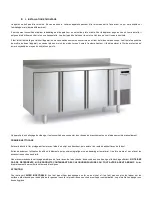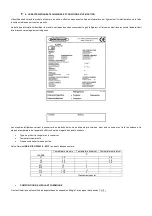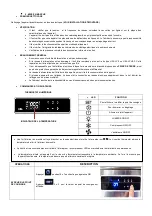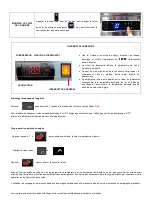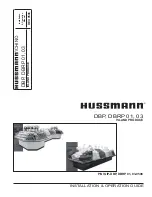
•
EVAPORATORS
Only for specialist personnel
The only maintenance the evaporators require is proper cleaning. This has to be done with the machine stopped and once the ice that may be
present on the fins has melted or once defrosting has been done by operating the controls. This process may be accelerated by using warm
water, NEVER using hard or sharp objects.
In order to clean the coil or the casing, DO NOT use chemical de-greasers with acid compounds or bleach, chlorine, ammonia or salts as all
these products aggressively attack copper and aluminium. Only water with well-diluted neutral detergents should be used or products especially
designed for cleaning the evaporators of refrigerated units. The cleaner the unit, the greater the energy saving.
•
AUTOMATIC EVAPORATION TRAY
Only for specialist personnel
The majority of the units are equipped with an automatic evaporation tray for the situations where an external outlet is not available to collect the
defrosted water from the evaporators. If this tray is not included, the drainage tubes have to be connected directly to the appropriate device or a
receptacle should be positioned in order to collect the water.
The defrost water can also cause breakdowns as the piping that brings the heat necessary for the water to evaporate can be punctured or the
electrical resistance can deteriorate.
The duration and number of defrosts the refrigerating equipment is regulated at the factory. The user should not change this regulation.
Attention should be given to this tray and regular cleaning is recommended.
•
DOOR SEALS
The rubber door seals are designed to ensure the closure of the doors to the cold chambers and to guarantee the sealing of the doors against
external elements.
A magnetic strip is housed on the inside of the rubber seal, which adheres it to the frame of the unit. Over time granular particles can become
stuck in the seal due to the effect of the magnet and these can rust and cause stains.
It is recommended that these door seals are kept free from foreign bodies that can cause rust, as well as fatty deposits which, over a long period
of time, can affect the rubber of the door seal.
Clean them with water, using neutral soap and a damp cloth. DO NOT USE DETERGENTS OR ABRASIVE PRODUCTS.
9. OPERATINAL TEST
•
CHECKS IN TE EVENT OPERATIONAL FAILURE
In some situations, operational failure can arise due to simple causes that users themselves can solve, which is why prior to requesting the
intervention of a specialised technician, we recommend that you carry out the following checks.
The appliance does not work
- Check that it is correctly plugged in.
- Check that electricity reaches the power outlet.
- Check that general switch is in the
I/ON
position.
The internal temperature is too high
- Check that there is no heat source nearby.
- Check that the grill is not obstructed.
- Check the Set-point.
The cleaning of the gas condenser must be carried out with the unit unplugged and
removing the protectors (grills) or taking out the condenser unit (depending on the
model)
In order to remove the dirt deposited between the condenser fins, any of the
following procedures are recommended:
•
Use a toothbrush or soft-bristle brush.
•
Blow the dirt using a suitable appliance.
•
Use air pressure to remove the dir.
Содержание BMR-150
Страница 13: ...11 ESQUEMA EL CTRICO 12 ESQUEMA FR O...
Страница 23: ...11 ELECTRIC SCHEME 12 COLD SCHEME...
Страница 33: ...11 SCH MA LECTRIQUE 12 SCH MA FROID...
Страница 40: ...PIEZAS DE REPUESTO SPARE PARTS PI CES DE RECHANGE...
Страница 41: ......
Страница 42: ......











